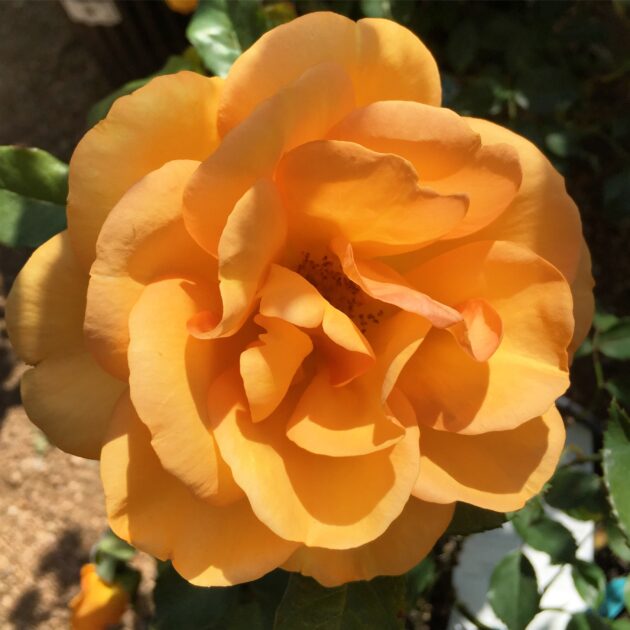
Companion Planting for Roses in Central Texas.
By HCWG Staff Horticultuaralist
Meghan Smith
Imagine a rose garden. What do you see?
Is it a tidy, gardener’s garden? Masses of shrub roses with rings of clipped, formal shrubs. Fountains. Tidy pathways between rose selections. Or maybe it’s a wild, secret garden: roses rambling over every surface, trees blooming, perennials bulbs, and flowers pushing up out of the ground.
Either way, your rose garden doesn’t have to just be roses! Expanding your plant palette beyond roses can make for beautiful, resilient gardens with more seasons of interest than roses alone. Here in Central Texas, roses are at their showiest and most beautiful in the middle of spring. As summer heats up, they begin to struggle, shut down entirely for the hottest months, and then pick back up in the fall before settling in for their slow winter growth and dormancy.
You can see, then, why it might be nice to brighten the rose garden off with some well-chosen companions: plants that can carry the display while your roses sleep, and complement them when they are at their most lovely. But roses have specific needs that can make them particular about their companions, too!
For the best companion planting success, look for plants that like the same things as roses. Rich soil with excellent drainage, high organic matter, and some acidity. Long, slow watering at soil level (no sprinklers, please! We mustn’t get those rose leaves wet!). 6-8 hours of sun, ideally mostly in the morning, and filtered light in the afternoon (and perhaps the companions could provide some of that shade from strategic placement!).
While we’re making wishes, wouldn’t it be great if the companion plants helped your roses out a little? Great news: many excellent rose companions will attract beneficial insects to your garden that can hunt down and eat bad guys like aphids and mealybugs. They’ll also help feed the pollinators that make your garden feel magical–butterflies, hummingbirds, and slow, fat bumblebees. Some can even repel insect pests like aphids, reduce the roses’ susceptibility to fungus, help keep deer away and help create healthy soil.
As you read, you might notice that this list has a lot in common with companion plants for a permaculture system called a food forest or fruit tree guild: that’s where you grow food in levels, with strategic placements of shade trees, food-producing fruit trees, and a lower level or understory where each plant serves some purpose as a living mulch, fixing nitrogen, building soil, attracting pollinators, or even producing food themselves. That’s because many of the commonly eaten fruits that we grow (apples, pears, blackberries, raspberries, peaches, plums, even strawberries) are all part of the rose family, prefer similar growing conditions, are prone to many of the same pests and diseases, and enjoy the company of the same groups of plants.
Interested? Here are some of our favorites.
Beautiful, Traditional Rose Companions
Garden designers always look for the same aesthetic traits when creating a garden around roses. Since rose blossoms tend to be big, fluffy, and showy–what we call a “thriller” in a flower or potted plant arrangement–the other plants are going to mostly be “fillers” and “spillers.” Think interesting foliage–silvery, soft, or variegated–and tall, spiky flowers. Roses usually aren’t blue, so designers often favor blue and purple flowers as their companions, but a garden in various shades of soft pinks, peaches, golds, and white can be fabulous, too.
For big, spiky flowers in central Texas, we often turn to salvias. Salvia “Mystic Spires” and Salvia “Henry Duelberg” simply can’t be beaten for drought tolerance, repeat blooming, and huge spikes of purple flowers–often several inches long. They’re also the absolute favorites of pollinators. We often see big, fuzzy yellow bumblebees on ours, spring through fall. For repeat blooms and compact plants, just cut them back by half whenever they stop blooming.
We also love penstemons! A drastically underused native perennial, penstemons have long spikes of fat, bell-shaped tubular flowers. There are lots of varieties, ranging from the small, extremely drought-tolerant, red Rock Penstemon, to the petite purple Gulf Coast Penstemon, to the red-tinged foliage and big, pink-tinged white flowers of Husker Red Penstemon.
Soft, silvery foliage is also always a hit in a rose garden. Artemisia “Powis Castle” makes a beautiful mid-size foliage plant, while soft, gray Lamb’s Ears look perfect in borders. Russian sage combines silvery foliage with blue flower spikes that look incredible during the hottest parts of summer, just when your roses are taking a break.
Insect Repellents and More
This may come as a surprise, but we love to fill a rose garden with herbs. Yes, herbs! Planting herbs amongst your roses can help keep your roses healthy, happy, pest-free, and can even make the flowers more fragrant.
Herbs often contain high levels of terpenes–a kind of naturally occurring chemical compound that is responsible for how plants smell. They can also produce essential oil production in plants nearby. This is why planting garlic and other alliums near your roses can make your roses smell better! In Central Texas, we love Society Garlic for its ornamental properties, but you can also use edible chives or even plant garlic cloves and grow your own garlic around your roses.
The stinky nature of many herbs is also partially responsible for their ability to help control pests. Not only can a barrier of garlic, bee balms, and other herbs keep deer back from your roses, they also help disguise the smell of insect pests’ favorite plants, making it harder for aphids and more to find your roses.
Some of our favorite ornamental herbs to plant around roses include groundcovers and border plants like thyme, catmint, marigolds, and rue. For shrubbier, mid-level plants, try lavender, rosemary, Mexican Oregano, Agastache, and Bee Balm.
Their Nectar Brings All the Beneficial Insects to the Yard
One of the central principles of Integrated Pest Management, or IPM, is that interplanting your valuable crops with plants that produce tons and tons of flowers with lots of nectar throughout the growing season keeps your beneficial insect populations high. Adult lacewings, ladybugs, hoverflies, and wasps all need lots of flower nectar to survive, while their juvenile counterparts devour aphids and other unpleasant bugs by the thousands.
Our biggest nectar-producing perennials are members of the aster family that produce compound flower heads with up to hundreds of nectar-producing structures per flower. Look for yarrow, fall aster, fragrant mistflower, and Gregg’s blue mistflower.
In addition to attracting lots of insect predators, these flowers are beautiful, and many of them will bloom when your roses themselves aren’t doing very much. To round out your season of flowers, try echinacea, rudbeckia, coreopsis, and even Texas rock rose.
Shrubs and Ornamental Trees
Formal rose gardens often include neatly trimmed shrubbery as a border to bigger shrub roses. While boxwoods might be a traditional choice, they can suffer from spider mites, struggle in Central Texas full sun, and don’t offer any benefits to your roses. Why not opt for Don’s Dwarf Wax Myrtle instead? It has similar bright green foliage, a nice spicy smell that can help ward off insects and deer, and it even fixes nitrogen, improving the soil around your roses. Eleagnus offers the same effects but with a silvery look instead of chartreuse. For even more flowers, choose one of the faster-growing abelias. They make a beautiful, dense green hedge, and the little sprays of fluffy pink flowers offer a surprising pop of interest where you expect simple greenery.
Consider, too, that small trees make a beautiful addition to any garden, including a rose garden. You can even site a small tree so that it protects your roses from the harsh afternoon sun. Many of our native trees, like the Anacacho orchid, Texas redbud, Texas kidneywood, and Texas mountain laurel are also legumes–they’ll add nitrogen to the soil around them, helping keep your roses healthy. And all of these trees have beautiful, delicate flowers that complement roses perfectly.
Texas persimmon
But what about…
But Meghan, you say. I googled “companion plants for roses” and I got lots of plants that aren’t on your list.
You’re in Texas now! Some of the plants that gardeners traditionally pair with roses just don’t grow very well here.
Take ornamental alliums. I love those big, fluffy purple pompoms just as much as the next gardener. I long to grow them, but they won’t bloom in Central Texas. They need weeks of cold temperatures in order to flower, just like fancy tulips, crocuses, and daffodils. In order to grow them here, you would have to dig them up and chill them in your refrigerator for several weeks each year, and I just don’t want to do that. That’s why I’ve suggested chives and society garlic instead. They’re less showy, but they thrive here without additional effort from you.
Other classic rose garden favorites, like delphiniums and foxgloves, aren’t for the faint of heart here in Central Texas. If you want to try them, you’ll need to start seeds in the fall, overwinter your plants carefully, expect a brief but lovely show in spring, and then watch them perish in the heat around May. That’s a lot of effort, and you can get a similar visual effect from our native penstemons.
Finally, even lavender can be challenging in Central Texas. If you’ve tried lavender without any luck and you want spiky purple flowers, look to salvias like Mystic Spires and Henry Duelberg. Rosemary is another option that can be less temperamental than lavender and provides a similar herbal scent, although the flowers are slightly less dramatic.
Looking for Inspiration?
We love to tour gardens! To see examples of public rose gardens in Texas, try:
Zilker Botanical Garden: The Mabel Davis Rose Garden is a beautiful example of a classic rose garden. https://zilkergarden.org/
Tyler Municipal Rose Garden: The largest public collection of roses in the United States! https://www.cityoftyler.org/government/departments/parks-rec/facilities/rose-garden-center
For more information on growing roses in Central Texas and a likeminded rose community, check out
Austin Rose Society: https://zilkergarden.org/garden-clubs/austin-rose-society/


You must be logged in to post a comment.